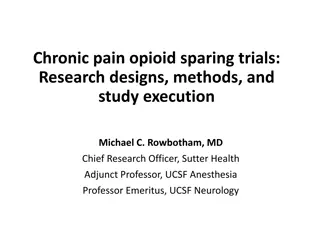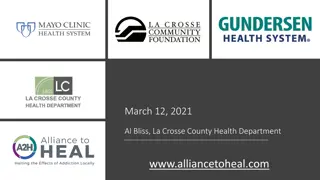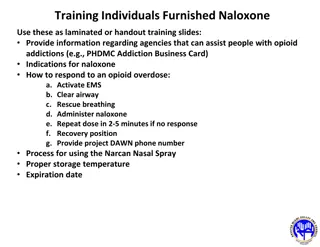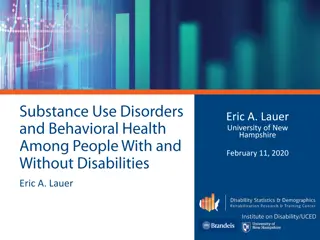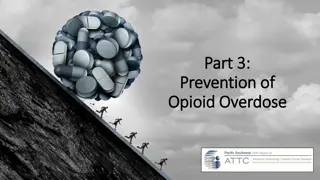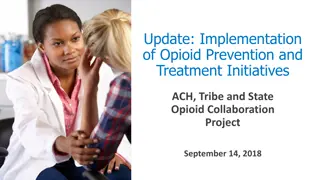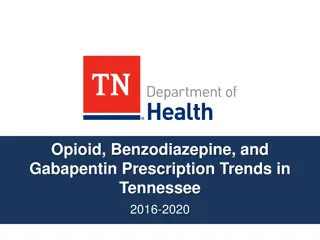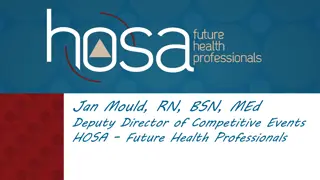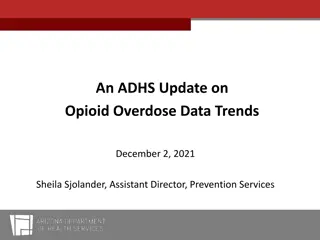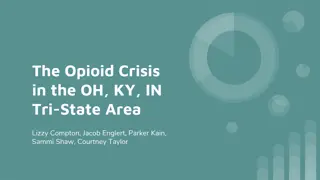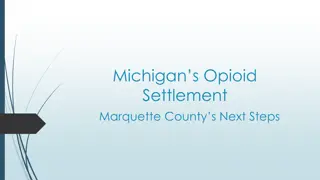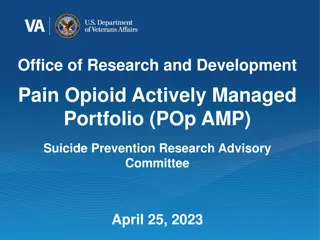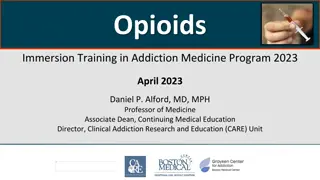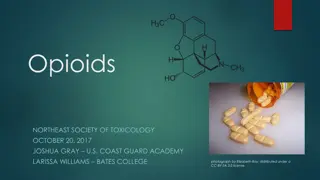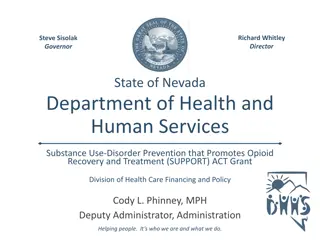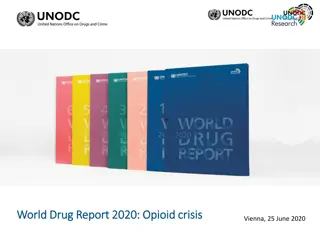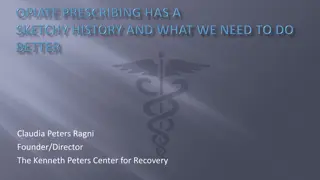Understanding Opioid Use and Prevention in School-Aged Children
This module developed by Angela Backus, Ph.D., and Renee Axiotis, Ph.D., for Kent State University teacher candidates provides an overview of Ohio House Bill 367 on Opioid Use Prevention, information on prescription opioids, heroin, fentanyl, national and state data on the opioid epidemic, how opioid use affects families, recognizing overdose signs, treatment options, and strategies to talk to school-aged children about opioids. Teachers play a crucial role in educating students about the dangers of opioid drugs and providing resources to prevent use and address addiction issues effectively.
Download Presentation

Please find below an Image/Link to download the presentation.
The content on the website is provided AS IS for your information and personal use only. It may not be sold, licensed, or shared on other websites without obtaining consent from the author. Download presentation by click this link. If you encounter any issues during the download, it is possible that the publisher has removed the file from their server.
E N D
Presentation Transcript
Opioid Learning Module Opioid Learning Module for Kent State University for Kent State University Teacher Candidates Teacher Candidates Developed by Angela Backus, Ph.D. and Renee Developed by Angela Backus, Ph.D. and Renee Axiotis Health Education and Promotion Health Education and Promotion Axiotis, Ph.D. , Ph.D.
In this module, you will find: An overview of the Ohio House Bill 367 on Opioid Use Prevention Information about prescription opioids, heroin, fentanyl National and state data on the opioid epidemic How opioid use affects families How to recognize when an overdose occurs and the treatment available for opioid overdose How to talk to school-aged children about opioids Resources to help you
The State of Ohio recognizes that opioid use affects school-aged children directly and indirectly. A new law requires that all schools teach children about the dangers of opioid drugs. This is where you come in as a teacher. You can make a difference in the drug use problems with which our communities struggle by helping to prevent use, recognizing patterns of addiction and providing resources for students and their families dealing with these issues. You are on the front lines of helping your students understand how to stay safe. These conversations can happen in any classroom and in any content area because when students hear this information in multiple places, they are more likely to retain the knowledge and skills that they learn. Let s get started!
Whats the problem with opioids? This NY Times article was written about the opioid problem in neighboring Akron, Ohio, and gives you a good perspective on the extent of the problem in our state. Drug Deaths in America Are Rising Faster Than Ever https://www.nytimes.com/interactive/2017/06/05/upshot /opioid-epidemic-drug-overdose-deaths-are-rising- faster-than-ever.html?mcubz=0
The Basics: Prescription Opioids, Heroin, and Fentanyl Read about prescription opioids here (be sure to select the tabs to read about the problem and the risk factors as well): https://www.cdc.gov/drugoverdose/opioids/prescribed.html Read about heroin here: https://www.drugabuse.gov/publications/drugfacts/heroin Read about fentanyl here: https://www.drugabuse.gov/publications/drugfacts/fentanyl
What factors contribute to heroin use? Prescription opioids are commonly prescribed for pain, for example, when wisdom teeth are extracted or a bone is broken. Most people who take prescription opioids will NOT become addicted. When used to treat chronic pain over a long period of time, the risk of addiction is greater. Because the Rx drugs are expensive, those who are addicted might turn to cheaper illegal versions like heroin and fentanyl. However, opioid addiction does not start with only Rx pain medications. People choose to use illegal opioids, like heroin, simply to get high or deal with emotional pain. Further, when a drug like heroin becomes more available at lower costs, the rates of use, addiction, and overdose increase. Availability and cost factors linked to heroin use: https://www.drugabuse.gov/publications/research- reports/relationship-between-prescription-drug-abuse-heroin- use/heroin-use-driven-by-its-low-cost-high-availability
How did heroin use become a national epidemic? This article explains the details about the heroin epidemic in the United States. Heroin and Opioid Addiction Statistics http://www.drugrehab.org/heroin-opioid-addiction- statistics/
Should I be concerned about student opioid use? Yes. This drug overdose report from the Ohio Department of Health clearly shows that middle and high school students are using prescription pain medications like oxycodone and Vicodin, and illegal opiates, including heroin and non- pharmaceutical fentanyl. Things you may notice that indicate a student may be using opioids include frequent absences, unusual drowsiness, shallow breathing, mood swings, slurred speech, euphoria (feeling high), irritability, lowered motivation In addition, students can be living in households where these drugs are present and/or living with adults who are using these drugs. 2016 Ohio Drug Overdose Data: General Findings https://www.odh.ohio.gov/- /media/ODH/ASSETS/Files/health/injury-prevention/2016-Ohio- Drug-Overdose-Report-FINAL.pdf?la=en
How does the opioid epidemic affect small children? As teachers, we should recognize that our students may be too young to use these drugs, but they may be living in environments where they are being used, have been exposed to these drugs while in the womb, or are experiencing drastic changes in living conditions and/or are in foster care when caregivers can no longer function effectively. https://www.childtrends.org/child-trends-5/5-things- know-opioid-epidemic-effect-children/
The Role of Teachers in Managing Student Opioid Use 1.Look for signs and symptoms of drug use in students 2.Understand school referral process for student drug rehabilitation Refer to your school s handbook and talk to other school personnel (counselors, assistant principals, nurses) 3.Identify community resources to assist with drug rehabilitation 4.Determine if Naloxone, a drug used to treat an overdose, is available in your school district 5.Keep the lines of communication open with students Ask students about their lives, learn the current language students are using to talk about drugs and addiction 6.Communicate concerns about students with appropriate colleagues (counselors, assistant principals, nurses) parents and/or caregivers
What happens when a person overdoses on opioids? Opioids affect a part of the brain that controls breathing. When a person overdoses, they can stop breathing and die within minutes. Because most opioid use is the illegal kind, it is impossible to know how potent the dosages are and what has been mixed with it. In this CNN video, watch how an overdose is treated: http://www.cnn.com/2016/04/28/health/what-is-naloxone- narcan-opioid-overdose/index.html
Treating an overdose A drug called Naloxone can be used to treat an overdose. Ambulances, hospitals, clinics and some schools have it on hand. In some states, prescriptions for Naloxone are available to anyone who wants to have it available to treat a possible overdose. Akron City Schools will have Naloxone in some middle and high schools: http://www.cnn.com/2017/07/14/health/akron-schools- opioid-overdose-prevention-trnd/index.html
The Dos of Drug Prevention Education DO: Talk to your students about safe drug use in a developmentally appropriate way. The Ohio Department of Education has resources available: http://education.ohio.gov/Topics/Learning-in- Ohio/Health-Education/Opioid-Abuse-Prevention Find ways to incorporate information about drug safety into lessons across content areas Teach your students about emotional resilience, problem-solving, communication and refusal skills Realize that students in your classroom may be dealing with family issues and need help or referral to school-based professionals Listen to what students are saying Support your health education professional(s) in your district and ask them for advice when needed Be an advocate for more preK-12 health education in your district
The Donts of Drug Prevention Education Don t: Use scare tactics. The data is clear that they don t work. Ignore signs of drug use in a student. Try a one-time approach, like a former addict or speaker. Data shows that these approaches do not work. Assume that you don t need to pay attention because someone else will deal with this in your school or community.
Lessons to Incorporate into Your Classroom Generation Rx-ideas for teaching about drug use for any teacher The mission of Generation Rx is to educate people about the potential dangers of misusing prescription medications. The resource includes an online classroom and informative videos for all ages http://www.generationrx.org/learn/understand-the- issue/
More about HB 367 and links with ideas for how to teach about drug use Substance Abuse Prevention Education Opioid drug abuse has become a crisis in Ohio and across the nation. Studies show that 1 in 5 teens abuses prescription medications not prescribed to them, and drug overdoses now surpass car crashes as the leading cause of accidental deaths in the U.S. In Ohio, the use of opiate pills and heroin is on the rise, with state troopers seizing 34,994 opiate pills and nearly 41 pounds of heroin in 2015. Providing opportunities for education around alcohol and drug abuse prevention and embedding the information into the school day is one way to strengthen efforts on this issue that affects nearly every Ohioan family and a means to prevent the issue before it starts. Because teachers can be powerful in uences in their students lives, they have a unique opportunity to guide students toward making healthy, drug- free lifestyle choices as well as building protective factors and resiliency skills that will help the student throughout their life. Overview / Awareness of HB 367 Governor Kasich s Cabinet Opiate Action Team recognizes the great capacity of school districts, classroom and health educators through House Bill 367- Opioid Abuse Prevention. In summary, the bill requires health education to include instruction in prescription opioid abuse prevention, with an emphasis on the prescription drug epidemic and the connection between prescription opioid abuse and addiction to other drugs, such as heroin. Although the bill is aimed at health educators, it is bene cial for all educators to be aware of the bill and to consider future collaborations with the other community sectors (ie: law enforcement, public health, coalitions, etc.) and internal partnerships. Resources to assist in curriculum building for all educators The Ohio Department of Education A website to map out resources and curriculum builders specific to grade levels http://education.ohio.gov/Topics/Ohios-Learning-Standards/ Health-Education/Opioid-Abuse- Prevention Start Talking! A platform for educators, parents, guardians, and community leaders to guide conversations with Ohio s youth about the importance of living healthy, drug-free lives http://starttalking.ohio.gov/AboutUs.aspx Generation Rx The mission of Generation Rx is to educate people about the potential dangers of misusing prescription medications.The resource includes an online classroom and informative videos for all ages http://www.generationrx.org/learn/understand-the-issue/ Department of Education
Community Resources The Ohio Department of Health (http://odh.ohio.gov) The Ohio Department of Education (http://education.ohio.gov) Local health department County Children s Services Agency County Department of Job and Family Services Local law enforcement Local medical providers Local mental health and chemical dependency treatment centers Faith communities
Opioid Module Opioid Module Questions Questions
1. Fentanyl and related drugs were involved in approximately ____% of all unintentional overdose deaths in 2016. A. 20 B. 38 C. 58 D. 75
2. Since the year 2000, death rates due to heroin in the U.S. have increase. Which of the following is NOT a likely reason why this increase has occurred? A. Purer heroin on the illegal drug market can cause accidental overdose B. Naloxone has become more difficult to obtain C. Other drugs are often combined with heroin and cause accidental overdose D. There has been an increase in the number of prescriptions written for opioid pain medications
3. True or False: 90% of people who use heroin used at least one other illegal drug prior to heroin
4. True or False: The majority of people who misuse prescription pain medications will eventually start to use heroin.
5. True or False: Children of parents with substance abuse issues are more likely than their peers to experience abuse and neglect.
6. Which of the following statements about fentanyl is true? Prescription fentanyl is associated with the recent increase in drug overdoses in the US. Overdoses of fentanyl cannot be reversed with Naloxone. Fentanyl is a stimulant drug that counteracts the effects of opiates like heroin. Non-pharmaceutical fentanyl mixed with heroin contributes to the increase in drug overdoses in the US.
7.Ohio House Bill 367 requires that: A. School districts require health education that includes information about prescription opioid abuse prevention B. School resource officers carry Naloxone C. Students caught using opioids be sent to treatment D. School districts partner with local law enforcement DARE programs
Answers: 1. C 2. B 3. True 4. False 5. True 6. D 7. A


